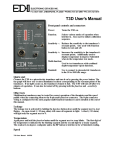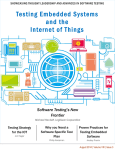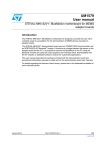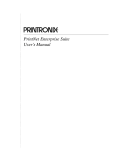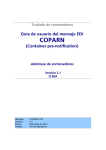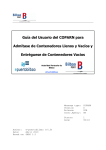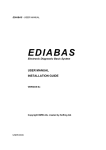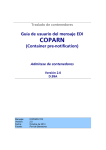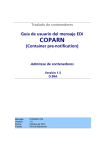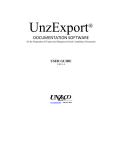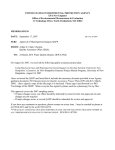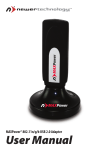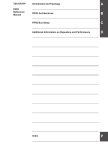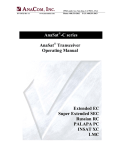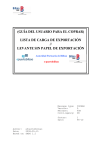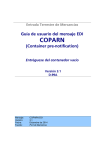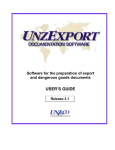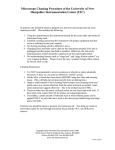Download PSAA Guidelines: COPARN
Transcript
GUIDELINES
COPARN
(D.95B version 1.4)
Department : PSA Antwerp EDI Support team
PSA Antwerp Guidelines COPARN
Introduction
This document is composed merely to facilitate the development of new EDI COPARN links with
our customers and to guide and assist them through the programming and test phase. This
should reduce the research and development on the customer side significantly.
As PSA Antwerp is an active participant of the world wide SMDG EDI discussion forum since its
foundation, this document is partially based on the SMDG COPARN user manual (Version 1.4),
enriched with some useful tips. It is not our intention to replace the official SMDG manual. These
guidelines should be used in addition to the COPARN manual.
Suggestions and/or feedback are always welcome, as this document is also based on
experiences, gained from past COPARN projects. Each time some new features are added, we
provide our customers with an update.
Best regards,
PSA Antwerp EDI Support team.
PSA ANTWERP GUIDELINES COPARN
1
The Container Announcement Instructions Message (COPARN)
The COPARN message is sent by the shipping agent to the container terminal operator/depot.
In Antwerp, PSA Antwerp can have both functions, which means that PSA Antwerp is to be
considered as a terminal operator/depot. The message can be used for import, export and
logistic movements. This message is the order for the release of empty containers,
announcement of the delivery of full or empty containers to the terminal. When it concerns a
release of containers, the shipping agent reports to the terminal operator that one or more
containers will be collected on a later date. In case of an announcement, the shipping agent
announces to the terminal operator that full or empty containers will be brought to the terminal
whether or not with the intention to be exported.
SEGMENT TABLE
UNB
UNH Message header
BGM Beginning of message
RFF Reference
Header
TDT
RFF
NAD
EQD
RFF
EQN
DTM
LOC
MEA
DIM
TMP
RNG
FTX
DGS
FTX
Details of transport
Reference
Name and address
Equipment details
Reference
Number of units
Date/time period
Place/location identification
Measurements
Dimensions
Temperature
Range details
Free text
Dangerous goods
Free text
Body
CNT
UNT
UNZ
Control total
Message trailer
Trailer
PSA ANTWERP GUIDELINES COPARN
2
SEGMENT TABLE: table of contents
Tag Name
Header
UNH Message header
BGM Beginning of message
RFF Reference
Segment group 1
TDT Details of transport
RFF Reference
Segment group 2
NAD Name and address
Segment group 7
EQD Equipment details
RFF Reference
EQN Number of units
DTM Date/time/period
LOC Place/location identification
MEA Measurements
DIM Dimensions
TMP Temperature
RNG Range details
FTX Free text
DGS Dangerous goods
Trailer
CNT Control total
UNT Message trailer
PSA ANTWERP GUIDELINES COPARN
3
I.
GENERAL INFORMATION
Basic rules
One booking reference per COPARN message
Only one booking reference can be specified per COPARN message, so a new COPARN
message should be sent for each booking reference.
One container type per booking reference/COPARN message
We also strongly suggest specifying only one container type per booking reference/COPARN
message. Otherwise the truck driver won’t be able to use the automated administrative check
in facilities at our terminals. As he then will be obliged to pass through the problem counter,
the waiting and treatment times at the gates of our terminal will be significantly higher.
One vessel – voyage combination per COPARN message
A COPARN container announcement message is composed per vessel, linked with a certain
voyage.
Please send the Coparn as frequently as possible (more than twice or three times a day).
PSA ANTWERP GUIDELINES COPARN
4
COPARN Message types
The following set of COPARN types is known and can be used. We will refer to these definitions
throughout the course of this guidelines document
Empty out COPARN (export booking)
This is an empty out instruction from the shipping agent to the container terminal (depot
function). This instruction will order the release of an empty container. The container will be
picked up at the HNN depot facility to be stuffed at an inland facility.
Technical characteristics of an empty out COPARN:
In the BGM-segment (header), data element 1001 has value “12”
In the EQD –segment (group 7), data element 8169 has value “4”
For more information see also “Order type - BGM-segment” and “Equipment details Group 7 EQD –segment”
Full in COPARN (export booking)
This message is an instruction from the shipping agent to the container terminal. This full in
instruction will order the acceptance by PSA Antwerp of a full container for export
admittance.
Technical characteristics of a full in COPARN:
In the BGM-segment (header), data element 1001 has value “11”
In the EQD –segment (group 7), data element 8169 has value “5”
For more information see also “Order type - BGM-segment” and “Equipment details Group 7 EQD –segment”.
Empty in COPARN (export announcement or stock announcement)
This is an instruction from the shipping agent to the container terminal. The empty in
instruction will order the acceptance by PSA PSA Antwerp of an empty in container.
Technical characteristics of an empty in COPARN:
In the BGM-segment (header), data element 1001 has value “11” (gate in)
In the EQD –segment (group 7), data element 8169 has value “4” (empty)
PSA ANTWERP GUIDELINES COPARN
5
Four situations are possible:
1) 1A/ Empty in for export shipping, empty container has to be loaded on a specific vessel:
Data element 8249 in EQD-segment has value “2” (=export). The container will be
stacked on our yard in a reserved area for empty containers to be exported /
shipped.
Vessel indication (in TDT segment) and voyage indication (in RFF segment) are
needed!
Operational port of discharge (in LOC segment).
1B/ Empty in for export shipping, empty container has to be loaded on any available
vessel:
Data element 8249 in EQD-segment has value “2” (=export). The container will be
stacked on our yard in a reserved area for empty containers to be exported /
shipped.
Vessel indication “VSMTI” (in TDT segment) and voyage indication “EMPTY” (in
RFF segment) are needed, the container will be stacked in the stock depot of
HNN.
Operational port of discharge (in LOC segment). If unknown = OPOPT = optional
port.
2) Empty in for depot fill up (Continental --> Depot).
Data element 8249 in EQD-segment has value “1” (=continental).
No vessel (TDT segment) and No voyage indication (RFF segment) needed, the
container will be stacked in the stock depot of HNN.
PSA ANTWERP GUIDELINES COPARN
6
3) Empty in return to HNN depot after being previously imported (e.g. full discharge from
vessel) and stripped at an inland facility.
Import: data element 8249 in EQD-segment has value “3” (=import).
4) Empty shipping from HNN depot and empty container has to be loaded empty onto a
vessel on the same quay / terminal (as the depot).
We do not need a Coparn because this will be covered by the Coprar (Loading
Order).
Coparn = Container announcement message. A container that is already present
in our HNN depot obviously does not have to be stacked and announced anymore.
PSA ANTWERP GUIDELINES COPARN
7
II.
SEGMENT INFORMATION
Interchange header – UNB –segment
Structure:
UNB
+
0001 = Syntax identifier with as value “UNOA” (indicates the use of level ‘A’ character set. => see
APPENDIX C for more information)
:
0002 = Syntax version number with as value “2”
+
0004 = Sender identification: mailbox number of the message sender
+
0010 = Recipient identification: mailbox number of the message recipient
+
0017 = Date of preparation (YYMMDD)
:
0019 = Time of preparation (HHMM)
+
0020 = Interchange control reference with a unique number which is also specified in the UNZ
segment
‘
Example:
UNB+UNOA:2+<SENDER>+101311+000508:1106+000005
PSA ANTWERP GUIDELINES COPARN
8
Message version - UNH-Segment
To head and identify the message type and version.
For mapping reasons, also enter the Association Assigned Code (0057) in the UNH-segment.
Structure:
UNH
+
0062 = Message reference number with as value a unique sequence number per message
+
0065 = Message type identifier with as value “COPARN”
:
0052 = Message type version number with as value “D”
:
0054 = Message type release number with as value “95B”
:
0051 = Controlling agency with as value “UN”
:
0057 = Association assigned code with as value the used manual version number (=”ITG12”)
‘
Example:
UNH+001054+COPARN:D:95B:UN:ITG12'
PSA ANTWERP GUIDELINES COPARN
9
Order type - BGM-Segment
To indicate the type and function of a message and to transmit the identifying number.
Data element 1001 in BGM-segment has to be coded with as value one of following codes:12 or 11
(= transport equipment movement inst.).
12 = Gate out move
11 = Gate in move
Structure:
BGM
+
1001 = Document/message name, coded with as value one of following codes:12, 11
+
1004 = Document/message number with as value the sender’s unique internal reference number
+
1225 = Message function, coded with as value one of following codes: 9, 2, 3, 4 (For further
information concerning these codes: see 3. Message Function-BGM segment)
‘
Example:
BGM+12+LMN309WECID000019+9'
PSA ANTWERP GUIDELINES COPARN
10
Message function - BGM-Segment (see APPENDIX D)
When sending EDI booking instructions, a certain order, regarding this message function, has to be
taken into account. The first message is always a creation of a booking. We call this the ORIGINAL
message. After this original message, several changes can be sent for that booking (e.g. container
number, weight of container, IMO, vessel, voyage number, …).
In the BGM segment, the code value of data element 1225 (message function, coded) indicates the
function of the message.
On message header level:
9 = ORIGINAL (CREATE): First transmission of the message and creation of the booking
The BGM segment with message function "9" is followed by the RFF segment with value
"XXX" (dummy value) as reference qualifier (1153) and with value "1" as reference number
(1154)
General usage:
To adapt (CHANGE, ADDITION…) the booking information created by the original
message, you always have to refer to that first (ORIGINAL) message. The BGM
segment is then followed by the RFF segment with as reference qualifier (1153) value
"ACW" (reference to a previous message), followed by the reference of the ORIGINAL
message as reference number (1154).
On message detail level :
2 = ADDITION : An addition of the detail information.
4 = CHANGE: A change of elements in the message.
3 = DELETION: To delete details in body information.
We recommend using additions and deletions for increasing and decreasing the number of
containers. Changing the number of containers is also possible using message function “4”
(CHANGE), but this method is not advisable.
PSA ANTWERP GUIDELINES COPARN
11
Message reference - RFF-Segment
The RFF at this level is used to transmit references which apply to the whole message and which
will link this message to later messages, reports/instructions which relate to the equipment
movement.
Structure:
RFF
+
1153 = Reference qualifier with as value “XXX” (= dummy value for original message) for ORIGINAL
or “ACW” (= reference to a previous message) for a CHANGE, REPLACE, DELETION –message
(see also appendix d)
:
1154 = Reference number with as value “1” (=dummy value) for ORIGINAL or the message
reference of the ORIGINAL message.
‘
Example:
RFF+XXX:1’
For further information see APPENDIX D
PSA ANTWERP GUIDELINES COPARN
12
1.
SEGMENT GROUP 1
A group of segments to indicate information regarding the main carriage.
This segment group identifies the main carriage or vessel details for all items of equipment in the
message.
1.1.
Vessel details - TDT Segment
In this segment all transport and vessel information can be specified:
Structure:
TDT
+
8051 = Transport stage qualifier with as value “20” (=main carriage)
+
8028 = Conveyance reference number with as value the carrier’s main voyage number
+
8067 = Mode of transport, coded with as value “1” (= maritime transport)
++
3127 = Carrier identification with as value the code of the vessel operator ( => See Appendix E)
:
1131 = Code list qualifier with as value “172” (= carrier code)
:
3055 = Code list responsible agency, coded with as value “20” (=BIC)
+++
8213 = Id of means transport with as value the international radio call sign
:
1131 = Code list qualifier with as value “103” (= radio call sign)
::
8212 = Id of the means of transport with as value the full name of the vessel (= optional)’
‘
Example:
TDT+20+1130+1++HYU:172:20+++3EXG9:103::DANUBE'
PSA ANTWERP GUIDELINES COPARN
13
1.2.
Vessel voyage number - RFF-Segment
This segment is always used to specify the main voyage number, or, if you are acting as co-loader,
the alternative voyage number. So also when you are not acting as co-loader, the main voyage
number which is also specified in the TDT-segment (above), has to be repeated in this segment.
Structure:
RFF
+
1153 = Reference qualifier with as value the code “VON” (= voyage number)
:
1154 = Reference number with as value the main voyage number or the alternative voyage number.
‘
For vessel MSC INSA:
•
•
•
•
The MSC carrier’s main voyage number is “0398”
For carrier operator “MSC” (Mediterranean Shipping Company), the alternative voyage
number for the MSC INSA is “001025”.
For co-loader “LTP” (Lloyd Triestino), the alternative voyage number for the MSC INSA is
“0248S”.
For co-loader “ACL” (Atlantic Container Lines), the alternative voyage number for the MSC
INSA is “0668”.
This means that we will receive three separate electronical booking messages:
- one from the shipping agent representing MSC
- one from the shipping agent representing LTP
- one from the shipping agent representing ACL
TDT and RFF segment in COPARN from shipping agent representing MSC:
TDT+20+0398+1++MSC:172:20+++3FWO5:103::MSC INSA'
RFF+VON:001025’
NAD+CF+MSC'
TDT and RFF segment in COPARN from shipping agent representing LTP:
TDT+20+0398+1++MSC:172:20+++3FWO5:103::MSC INSA'
RFF+VON:0248S’
NAD+CF+LTP'
TDT and RFF segment in COPARN from shipping agent representing ACL:
TDT+20+0398+1++MSC:172:20+++3FWO5:103::MSC INSA'
RFF+VON:0668’
NAD+CF+ACL'
When we are to report the loading operation for vessel MSC INSA electronically (COARRI loading
report message), we will in return use the same alternative voyage numbers to report to the parties
concerned. In this example, these parties are the shipping agents, representing MSC, LTP and
ACL.
PSA ANTWERP GUIDELINES COPARN
14
2.
SEGMENT GROUP 2
A group of segments to identify a party and/or addresses and related contacts.
This segment group is mandatory in the message and must always be used.
2.1. Container operator code - NAD-Segment
This segment specifies the name/address and their related function. As Party Qualifier (3035),
value "CF" (Container operator) has to be used.
Structure:
NAD
+
3035 = Party qualifier with as value “CF” (=container operator)
+
3039 = Party id identification with as value the name of the line agency ( => See Appendix F)
‘
Example:
NAD+CF+HYU'
PSA ANTWERP GUIDELINES COPARN
15
3.
SEGMENT GROUP 3
3.1.
Goods item details - GID-Segment
3.2.
Handling instructions - HAN-Segment
3.3.
Free text - FTX-Segment
4.
SEGMENT GROUP 4
4.1.
Name and address - NAD-Segment
4.2.
Date/time/period - DTM-Segment
4.3.
Reference - RFF-Segment
4.4.
Measurements - MEA-Segment
4.5.
Dimensions - DIM-Segment
5.
SEGMENT GROUP 5
5.1.
Split goods placement - SGP-Segment
5.2.
Measurements - MEA-Segment
6.
SEGMENT GROUP 6
6.1.
Dangerous goods - DGS-Segment
6.2.
Free text - FTX-Segment
6.3.
Measurements - MEA-Segment
PSA ANTWERP GUIDELINES COPARN
16
7.
SEGMENT GROUP 7
A group of segments to specify containers in which goods are transported.
This segment group must always be sent in the COPARN message.
7.1.
Equipment details - EQD-Segment
To identify a unit of equipment.
The EQD segment must always be sent.
Structure:
EQD
+
8053 = Equipment qualifier with as value “CN” (=container)
+
8260 = Equipment identification number with as value the container number (see remark below)
+
8155 = Equipment size and type identification with as value the ISO code for the corresponding
container (see below: “Specification of empty out containers” and “ISO code matching”)
:
1131 = Code list qualifier with as value “102” (=size and type)
:
3055 = Code list responsible agency, coded with as value “5” (= ISO)
++
8249 = Equipment status, coded with as value “2” (= export) or “3” (=import) or “1” (=continental)
+
8169 = Full/empty indicator, coded with as value “4“ (= empty) or “5” (= full)
‘
Examples :
Full In (with ISO-code):
Empty Out (with ISO-code):
(Full in with container number):
EQD+CN+ +4210:102:5++2+5'
EQD+CN+ +4210:102:5++2+4' (see also “Specification
of empty-out containers” and “Iso code matching”)
EQD+CN+TRLU1234567+4210:102:5++2+5'
7.1.1. Specification of empty-out containers:
ISO code:
In the EQD segment, the value for data element 8155 (Equipment size and type identification) is
the iso code for the corresponding container. This element is then followed by Code list qualifier
(1131) with value "102" and Code list responsible agency coded (3055) with value "5"
Example:
EQD+CN++4500:102:5++2+4'
PSA ANTWERP GUIDELINES COPARN
17
7.1.2. ISO code matching:
By iso code matching we define a sequence of equivalent relations between the various iso
codes which are used by the customers.
Definition of “equivalent relations” = equal in value, ISO codes with the same characteristics.
Example of such equivalent relations:
22GP = 22G0=22G1=2200=2210
22VH = 22V2=22V3=22V0=2214=2215=2213
22UT = 22U1=2251
22UP = 22U6=2258=2259
29PL=29P0=2960
22PF=22P1=2261
22PC=22P3=22P8=2263=2268
22RT=22R1=2232
22RC=22R9=2239
42GP=42g=42G1=4300=4310
45GP=45G0=45G1=4500=4510
42UT=42U1=4351
42UP=42U6=4358=4359
45UP=45U6=4559
49PL=49P0=4960
42PF=42P1=4361
42PC=42P3=42P8=4363=4368
4310=4311
45PC=45P3=45P8=4563=4568
All containers with the same characteristics (for example 40 foot, Dry Van 8,6 foot) are
physically stacked together on our yard in blocks (for example 6 containers wide and 4
containers high). But not all containers have the same ISO code, because there exist
containers with the same characteristics but with different ISO codes. For example, as well ISO
code 4310 as 4311 stands for a 40 foot-Dry Van-8,6 foot container.
Imagine that there is stacked an empty container
in your pool with ISO 4310 at the bottom of the
empty stack with 3 empty containers on top of it.
And there is stacked a container with ISO 4311 on
top of the stack. These are two containers with
the same characteristics (see equivalent relations
table provided by the customer 4310=4311).
If you then specify in the booking ISO code "4310",
which stands for a 40 foot container- dry Van-8,6 ,
which also stands for iso code “4311”, we can
simply take a container on top of the stack, without
shifting. This can save a lot of time.
Stack of empty 40FT DV 8,6 ft containers
4311
4310
So if HNN receives a COPARN with an ISO code which is not available at the moment, HNN
can use the ISO code matching, using the equivalent relations (provided by the customer), to
select an other container with equal characteristics but with another ISO code.
PSA ANTWERP GUIDELINES COPARN
18
This way of working makes it a lot more efficient and time saving to physically retrieve a
container from your pool of empty stock on our depot yard, which is also in the advantage of the
shipping agency.
7.1.3. Specification of container number in EQD:
It’s possible to give multiple container numbers for one booking reference. You just have to
repeat the EQD-group
The container numbers can in some cases be retrieved from the gate out daily moves that we
report frequently. (CODECO message)
In some cases the container number will be unknown (cross bookings,…), then just omit the
container number.
Example:
UNB+UNOA:2+115500+101302+991224:1100+000887'
UNH+001342+COPARN:D:95B:UN:ITG’
BGM+11+AVW00001+9'
RFF+XXX:1'
TDT+20+RH35E+1++HYU:172:20+++3ECE7:103::RHEIN BRIDGE'
RFF+VON:RH35E'
NAD+CF+HYU'
EQD+CN+GATU1234589+2200:102:5++2+5'
RFF+ANN:TST99999'
EQN+1'
LOC+8+BEANR:139:6+BEANR869:TER:ZZZ'
LOC+9+BEANR:139:6'
LOC+11+HKHKG:139:6'
LOC+163+HKHKG:139:6'
MEA+AAE+TGW+KGM:18000'
MEA+AAE+MW+KGM:24000'
EQD+CN+GATU4321589+2200:102:5++2+5'
RFF+ANN:TST99999'
EQN+1'
LOC+8+BEANR:139:6+BEANR869:TER:ZZZ'
LOC+9+BEANR:139:6'
LOC+11+HKHKG:139:6'
LOC+163+HKHKG:139:6'
MEA+AAE+TGW+KGM:18000'
MEA+AAE+MW+KGM:24000'
CNT+16:2'
UNT+26+001342'
UNZ+1+000887'
Remark:
When the container number is provided, the EQN-segment has value 1 for obvious reasons.
PSA ANTWERP GUIDELINES COPARN
19
7.2.
Booking reference number - RFF-Segment
In this segment, the corresponding booking reference is specified:
Structure:
RFF
+
1153 = Reference qualifier with as value “ANN” (= Transport Equipment Announcement Number)
:
1154 = Reference number with as value the corresponding booking reference
‘
Example:
RFF+ANN:ANTA000001'
PSA ANTWERP GUIDELINES COPARN
20
7.3.
Sequence reference number – RFF segment
Some shipping lines are making use of a sequence number model COPARN
(see also Appendix G “The use of either the EQN segment or the RFF+SQ segment”)
In the RFF segment the corresponding sequence number can in that case be specified:
Structure:
RFF
+
1153 = Reference qualifier with as value “SQ” (= Container Sequence Number)
:
1154 = Reference number with as value the corresponding sequence number
‘
Example:
RFF+SQ:10’
PSA ANTWERP GUIDELINES COPARN
21
7.4.
Number of equipment - EQN-Segment
To specify the number of units.
This segment has a value different from 1 (if it isn’t one container) when the container number is not
known for the booking references (cross bookings,...).
The maximum number of units (detail lines) in the EQN-segment (data element 6350) is limited.
Because of safety reasons (database overflow), our system can only generate “999” of detail lines
per reference.
Structure:
EQN
+
6353 = Number of units
‘
Example:
EQN+5' => for an EQD –detail with 5 containers
PSA ANTWERP GUIDELINES COPARN
22
7.5.
Date/time period - DTM-Segment
The DTM-segment is used to report dates and times relating to the item of equipment.
When you add one ore both segments to the message, the containers of the booking will be on hold
until the limited start date and/or from the limited end date.
Structure:
DTM
+
2005 = Date/time/period qualifier with as value 7 and 36 (see below)
:
2380 = Date/time/period
:
2379 = Date/time/period/ format qualifier with as value 203 (format: CCYYMMDDHHMM)
‘
Values:
2005: value
7 = Limited start date
36 = Limited end date
Example:
DTM+7:200008180600:203'
DTM+36:200008221900:203'
PSA ANTWERP GUIDELINES COPARN
23
7.6.
Location - LOC-Segment
The LOC-segment is used to report locations which relate to the movement of the container.
Structure:
LOC
+
3227 = Place/Location qualifier with as value “5”, “8”, ”11” or “163” (see below: possible place
location qualifiers (3227) )
+
3225 = Place/Location identification with as value the Locode of the port of departure
e.g.: “BEANR” or “BEZEE”
:
1131 = Code list qualifier with as value “139” (= port)
:
3055 = Code list responsible agency, coded with as value “6” (= UN/ECE)
+
3223 = Related place/location one identification with as value the corresponding PSA Antwerp
terminal code (e.g. K869, Z206…) (!! Only for LOC+5 or LOC+8) See also “Place of departure” and
“Place of destination”
:
1131 = Code list qualifier with as value “TER” (= Terminals) (!! Only for LOC+5 or LOC+8). See also
“Place of departure” and “Place of destination”
:
3055 = Code list responsible agency, coded with as value “ZZZ” (= mutually agreed) (!! Only for
LOC+5 or LOC+8)
‘
PSA ANTWERP GUIDELINES COPARN
24
7.6.1. Possible Place/Location qualifiers (3227) :
Place of departure: (PSA Antwerp terminal) (LOC+5)
The LOC –segment with “5” as place/location qualifier is only used for an empty out
instruction. In the empty out move, the PSA Antwerp container terminal/depot has to be
considered as the place of departure where the container is released by PSA Antwerp from
the empty stock and picked up by truck, train or barge.
(*) The Related Location One Identification can have one of the following values:
“BEANR869” for quay 869 (Europaterminal)
“BEANR420” for quay 420 (Churchilldok)
“BEANR913” for quay 913 (Noordzeeterminal)
“BEZEE206” for quay 206 (Container Handling Zeebrugge)
“BEANR1742” for quay 1742 (Deurganckdok)
(See http://www.smdg.org/ documents code list SMDG Terminal Facilities codes list.)
Example:
LOC+5+BEANR:139:6+BEANR869:TER:ZZZ'
Place of destination: (PSA Antwerp destination terminal) (LOC+8)
The LOC –segment with “8” as place/location qualifier is only used in a gate in instruction
(full or empty). In this case, the PSA Antwerp container terminal has to be considered as
place of destination where the container is delivered full or empty by truck, train or barge.
Example:
LOC+8+BEANR:139:6+ BEANR869:TER:ZZZ'
Port of discharge: (LOC+11) SPOD
The operational port of discharge is the port of destination from the vessel point of view. In
that port, the goods may be transhipped to another vessel and continue their voyage to their
final port of destination (= LOC+163: see below). To specify this place/port, qualifier ”11” has
to be used.
Example:
LOC+11+SGSIN:139:6'
PSA ANTWERP GUIDELINES COPARN
25
Place of destination for stowage purposes: (LOC+163) POD
The place of delivery is the final port of destination from the goods point of view. From there,
they will be transported to an inland destination by truck, train or barge... To specify this port,
qualifier “163” has to be used.
Example:
LOC+163+CNYTN:139:6'
But if the final port of destination is already an inland destination, then the LOC+163 =
LOC+11
A container terminal like HNN does not organise overseas inland transports (we are on the
other side of the ocean…) and therefore overseas inland transport is not the scope nor the
responsibility of a terminal operator.
Our IT systems are not destined and not designed for it… therefore this info generates errors
in our EDI systems…
So this inland transport info needs to be visible only to overseas inland transport operators or
forwarders / shipping customers only.
Container terminals always have a port scope of two ahead, so worst case for HNN is
something like:
SG SIN (Port of Singapore) / JP UKB (Port of Kobe, Japan).
Origin: we always inform the next coming container terminal (via BAPLIE EDI message) in this
case of the port of Singapore.
We tell them that the container will be transhipped to Kobe so that they stack it in their yard
properly…
In the port of Kobe our scope ends for HNN.
If the port of Kobe a second transhipment occurs to for example Sydney, Australia, then
Sydney is not the scope of HNN anymore, it does belong to the scope of container terminal
PSA in Singapore, two ports ahead so PSA has a scope port of Kobe and the port of
Sydney…
All SMDG container EDI messages that we use together are designed in that way… a terminal
scope of maximum two ports ahead…
PSA ANTWERP GUIDELINES COPARN
26
Port of loading: (LOC+9)
To specify the operational port of loading, qualifier “9” has to be used. The port code itself is
always to corresponding UN Locode (e.g. BEANR, BEZEE, NLRTM …)
Example:
LOC+9+BEANR:139:6'
PSA ANTWERP GUIDELINES COPARN
27
7.7.
Weight - MEA-Segment
The MEA-segment is used to report weights which relate to the container.
7.7.1. CSC-Weight
The CSC-weight is the maximum weight which can be loaded on the container and for which the
container is tested.
This segment is only used for empty out instructions. In case the CSC-weight is known, it should be
specified in the MEA-Segment under group 7.
Structure:
MEA
+
6311 = Measurement application qualifier with as value “AAE” (= Measurement)
+
6313 = Measurement dimension, coded with as value “MW” (Maximum CSC Gross Weight)
+
6411 = Measure unit qualifier with as value “KGM” (= Kilogram)
:
6314 = Measurement value with as value the actual maximum weight (for example: “24000” for 20
FT and “30000” for 40 FT containers).
‘
Example:
MEA+AAE+MW+KGM:24000' (for 20' container)
In case the number of units (6350) in EQN segment is more than 1, the CSC-weight is valid for all
containers in that EQD-group.
Example:
EQD+CN++2330:102:5+1+2+4'
EQN+2'
MEA+AAE+MW+KGM:24000'
=> both containers have a CSC-weight of 24000 KGM
PSA ANTWERP GUIDELINES COPARN
28
7.7.2. Gross-Weight
The Total Gross Weight is the total weight of the container and should be specified in the MEASegment under group 7. This segment is only used for full in instructions. If you want to specify a
number of unknown container numbers through usage of the EQN segment, then the weights of
these containers has to be added up into one value.Structure:
Structure:
MEA
+
6311 = Measurement application qualifier with as value “AAE” (= Measurement)
+
6313 = Measurement dimension, coded with as value “TGW” (Total Gross Weight)
+
6411 = Measure unit qualifier with as value “KGM” (= Kilogram)
:
6314 = Measurement value with as value the total gross weight (for example: “24600” ).
‘
Examples:
MEA+AAE+TGW+KGM:30000'
( In case the number of units (6350) in EQN segment is more than 1, the Total Gross Weight is
the total weight for all containers in that EQD-group.)
EQD+CN++2330:102:5+1+2+5'
EQN+2'
MEA+AAE+TGW+KGM:60000'
=> total gross weight = 2 x 30T/container
PSA ANTWERP GUIDELINES COPARN
29
7.8.
Overheight / Oversized containers - DIM-Segment
The Group 7 DIM-Segment is used to specify dimensions, which exceed those of the standard
reported in the preceding EQD-Segment. As Dimension Qualifier (6145), following values are
possible:
"5"
"6"
"7"
"8"
"9"
=> Off-standard dimension front (over-length)
=> Off-standard dimension back (over-length)
=> Off-standard dimension right (over-width)
=> Off-standard dimension left (over-width)
=> Over-height
Structure:
DIM
+
6145 = Dimension qualifier with as value “5” or “6” or “7” or “8” or “9” (see above)
+
6411 = Measure unit qualifier with as value “CMT” (= centimeters)
:
6168 = Length dimension with as value the over-length
:
6140 = Width dimension with as value the over-width
:
6008 = Height dimension with as value the over-height
‘
Examples:
For over-length, front: DIM+5+CMT:20’
For over-length, back:DIM+6+CMT:30’
For over-width, right: DIM+7+CMT::15’
For over-width, left: DIM+8+CMT::15’
For over-height:
DIM+9+CMT:::50'
Also a combination is possible, for example a container with an over-length of 20 cm, an over-width
(right and left) of 10 cm and an over-height of 30 cm:
...
DIM+5+CMT:20'
DIM+7+CMT::10'
DIM+8+CMT::10’
DIM+9+CMT:::30'
...
PSA ANTWERP GUIDELINES COPARN
30
Remark:
It is very useful if the customer can mention the overdimensions of a container and we can put them
into our container terminal management system.
If we do not know on beforehand that a container has overdimensions, the container will be preplanned in the normal container stack area on the yard. This pre-planning occurs at the gate in
administrative check point.
If we notice overdimensions at the technical check point at the gate-in, the yard planning department
will have to re-plan the container manually (we are trying to reduce this to a minimum).
For the truck driver carrying your cargo this can be an extra problem; he can get another parking /
truck and liftfork instruction through which he has to wait unnecessary.
It is also clear that in those situations the PSA Antwerp logistic chain is not running as smooth as we
like to see it running.
PSA ANTWERP GUIDELINES COPARN
31
7.9.
Fixed reefer temperature specification - TMP-Segment
To specify a fixed reefer temperature setting, the Group 7 TMP-Segment is used and is composed
as follow:
The temperature qualifier (6245) with value "2" is followed by the temperature setting (6246).
This is a 3-digit integer number. ("." excluded)
Examples:
* "20.0" returns 020°
* "09.0" returns 009°
As measure unit qualifier, one of next two values is possible:
- "CEL" for degrees Celsius
- "FAH" for degrees Fahrenheit
Structure:
TMP
+
6245 = Temperature qualifier with as value “2” (= transport temperature)
+
6246 = Temperature setting with as value the actual fixed temperature (see above)
:
6411 = Measure unit qualifier with as value the code “CEL” (=Celsius) or “FAH” (=Fahrenheit)
‘
Examples:
* TMP+2+10.0:CEL' returns 010°C
* TMP+2+05.0:CEL' returns 005°C
* TMP+2+-05.0:CEL’ returns –005°C
☞ Temperature setting should be given as described above. Certain combinations are not
supported and should never be used:
* TMP+2+00,0: CEL’ comma
* TMP+2+00.0’ no measure unit qualifier
* TMP+2+00.0°: CEL’ « ° »
etc…
Result: a translation error; the file can not be processed automatically. Manual intervention or
resending the EDI file is needed to process the booking order.
PSA ANTWERP GUIDELINES COPARN
32
7.10. Range of reefer temperatures - RNG-Segment
The RNG segment is used to specify a range of temperatures.
The Group 7 RNG-Segment is used to specify temperature ranges. As range type qualifier (6167),
value "5" (=temperature range) has to be entered. Next, the Measure unit qualifier (6411) with
values "CEL" or "FAH" (see 14) is followed by: first the minimum (6162), then the maximum (6152)
temperature.
Structure:
RNG
+
6167 = Range type qualifier with as value “5” (= temperature range)
+
6411 = Measure unit qualifier with as value the code “CEL” (=Celsius) or “FAH” (=Fahrenheit)
:
6162 = Range minimum with as value the minimum temperature
:
6152 = Range maximum with as value the maximum temperature
‘
Example:
RNG+5+CEL:-09.0:05.0' for a range from -009°C to 005°C
☞If there is a range of temperatures given, the Group 7 RNG-segment should be used instead
of the TMP-Segment.
☞ Mind that Numeric data element values shall be regarded as positive. ...
temperature is specified without the "+"-sign.
So positive
☞ The temperature or range specification is automatically interpreted as an instruction for
connecting the container to a reefer unit on our terminal with the instructed temperature!!!
☞ Temperature setting should be given as described above. Certain combinations are not
supported and should never be used:
* RNG+5+CEL:-09,0:05,0’ comma
* RNG+5+-09.0:05.0’ no measure unit qualifier
* RGN+5+-09.0°:05.0° : CEL’ « ° »
etc…
Result: a translation error; the file can not be processed automatically. Resending the EDI file
is needed to process the booking order.
PSA ANTWERP GUIDELINES COPARN
33
7.11. Instructions for special services or actions - FTX-Segment
7.11.1. Stowage instructions
This segment is used to specify the stowage instructions. As Text Subject Qualifier (4451) "HAN"
has to be specified. As Free Text Coded (4441) next values can be entered:
-
BB
BH
BS
FO
HH
NB
OD
OB
TD
UB
UD
UW
WD
=
=
=
=
=
=
=
=
=
=
=
=
=
Seperated from heating
Seperated from heating
Block stow
FORD Containers (Canmar)
Hot hatch / top priority
No bottem stow
On deck stowage
On deck / stow away
twin deck
Under deck, seperated from heating
Under deck stowage
Under waterline
Weather deck
Structure:
FTX
+
4451 = Text subject qualifier with as value “HAN” (=handling instruction)
++
4441 = Handling code with as value “OD”, “UD”, … (see above)
:
1131 = Code list qualifier with as value "130" (special handling if e4451 = "HAN")
:
3055 = Code list responsible agency, coded "184" (= ACOS = Australian Chambers Of Shipping)
‘
Remark:
The usage of qualifiers "130" and "184" are strongly suggested by the SMDG organisation. (for
more details see the corresponding SMDG documentation: COPARN V1.4 page 58 , COARRI V1.2
page 32 )
Example:
FTX+HAN++OD:130:184' for on deck stowage.
PSA ANTWERP GUIDELINES COPARN
34
7.11.2. General information
Specifying general information should be done in the FTX segment with as Text Subject Qualifier
(4451) "AAI" (=general information).
!! Please note that a free text segment can't be interpreted by a computer system. Therefore we
advise to put as less information as possible in this segment.
Structure:
FTX
+
4451 = Text subject qualifier with as value “AAI” (=general information)
+++
4440 = Free text with as value a description/instruction/remark
‘
Example:
FTX+AAI+++HEAVY PAYLOAD’
➲ For more information about this FTX segment: see appendix B
7.11.3. Goods description
Specifying goods description should be done in the FTX segment with as Text Subject Qualifier
(4451) "AAA" (=goods description).
Structure:
FTX
+
4451 = Text subject qualifier with as value “AAA” (=goods description)
+++
4440 = Free text with as value a description/instruction/remark
‘
Example:
FTX+AAA+++ZINC PLATE'
PSA ANTWERP GUIDELINES COPARN
35
7.11.4. Damage Remarks.
This instruction will order the release of an empty container in Bad condition (= out of service).
Specifying status of the container should be done in the FTX segment with as Text Subject Qualifier
(4451) “DAR” (= damage remarks).
Structure:
FTX
+
4451 = Text subject qualifier with as value “DAR” (=damage remarks)
++
4441 = Free text, coded = BD (Bad = out of service)
:
1131 = Code list qualifier = ZZZ
:
3055 = Code list resp . agency, coded = 184
Example:
FTX+DAR++BD:ZZZ:184’
PSA ANTWERP GUIDELINES COPARN
36
7.11.5. Additional conditions (status conditions)
Specifying quarantine status should be done in the FTX segment with as Text Subject Qualifier
(4451) "ABS" (=additional condition).
Structure:
FTX
+
4451 = Text subject qualifier with as value "ABS" (=additional condition)
++
4441 = Free text
:
1131 = Code list qualifier with as value "ZZZ"
:
3055 = Code list responsible agency, coded "184" (=ACOS)
'
Example:
FTX+ABS++FS:ZZZ:184’
In this example is shown how "foodstuff" quality containers are to referred to. This can be performed
by indication of "FS" in the FTX segment with qualifier "ABS".
Common Quarantine status codes within PSA Antwerp are:
−
−
−
"FS" Food stuff
"PW" Pallet wide
“VS” Vessel
PSA ANTWERP GUIDELINES COPARN
37
7.11.6. Blocking functionality
If you wish to block a full container for shipment, this can be specified with a combination of three
FTX segments with Text Subject Qualifier (4451) "HAN", “AAA” and “ABS”.
Structure:
FTX
+
4451 = Text subject qualifier with as value "HAN" (=handling instruction)
++
4441 = Free text with as qualifier “BLK” (= Block)
:
1131 = Code list qualifier with as value "130"
:
3055 = Code list responsible agency, coded "184" (=ACOS)
'
FTX
+
4451 = Text subject qualifier with as value "AAA" (=goods description)
+++
4440 = Free text with as value a description of the goods
'
FTX
+
4451 = Text subject qualifier with as value "ABS" (=additional condition)
++
4441 = Free text with as qualifier “VS” (=vessel)
:
1131 = Code list qualifier with as value "ZZZ"
:
3055 = Code list responsible agency, coded "184" (=ACOS)
'
Example:
FTX+ HAN++BLK:130:184’
FTX+AAA+++CIGARETTES’
FTX+ABS++VS:ZZZ:184’
PSA ANTWERP GUIDELINES COPARN
38
What happens with the COPARN message in our system?
Your COPARN message is processed automatically in our system like any other COPARN message
would enter our system, but there are a few differences.
In the booking in our system there will be a special instruction to block the container for shipment.
The goods provided in the COANIN message will be blanked so it is not possible for an employee
to find out what is transported in the container.
What are the consequences for the customer and the container?
If the steps in 1) are followed and COANIN message was processed correctly , there is a special
instruction in the booking.
From the moment the container(s) is delivered to HNN, the container(s) is blocked for shipment.
The container will be stacked on the yard between the other containers for the same vessel. In
this way it is impossible to separate cigarette containers from other containers.
The only way the container can leave quay is with the vessel provided in the booking if the
container is mentioned on the loading order.
If the container should leave quay in an other way than vessel (truck, barge or rail), the customer
should send us a special instruction to deblock the container and send a full release order.
Otherwise it is impossible to pick up the container!
In case the container missed the departure of the vessel, the container is transferred to the next
vessel with the same destination by the yard responsible.
It is not necessary to send a deblocking for the container in this case.
PSA ANTWERP GUIDELINES COPARN
39
7.12. Multiple dangerous goods and limited quantities in one container - DGSSegment & FTX-segment
Maximum 9 multiple dangerous goods can be specified in the DGS-group with a DGS-segment,
followed by a FTX-segment with either as text subject qualifier (4451) “AAD”(= dangerous goods
technical name) and / or a FTX –segment with as text qualifier (4451) “AAC” (= dangerous goods
additional information).
Every DGS segment should be followed by the FTX segment with qualifier “AAD”. If a limited
quantities regulation is applicable, also an FTX segment with qualifier “AAC” is to be used. The
limited quantities regulations are in general applicable when the dangerous goods are transported in
small quantities and when these dangerous goods are packed in accordance with these regulations.
Structure:
DGS
+
8273 = Dangerous goods regulations = "IMD"
+
8351 = Hazard code identification = IMDG Class Number or Sub Class Number
+
7124 = UNDG Number
‘
Dangerous goods technical name:
FTX
+
4451 = Text Subject qualifier with as value “AAD” = (dangerous goods technical name)
+++
4040 = Free text
‘
☞As “FTX+AAA” is a general description of the goods in an EQD segment, the “FTX+AAD”
segment is the more specific technical name per commodity.
☞In case there are more than 9 commodities for one container (for one EQD segment), we
suggest specifying the 9 most important/dangerous goods.
☞For flax waste (IMDG class 4.1), there doesn’t exist an official UN number. We suggest to
use “0000” as UN number for this commodity.
+Our system will recognise Marine Pollutant related UN numbers and will process this
information automatically (exception: in combination with limited quantity).
PSA ANTWERP GUIDELINES COPARN
40
Dangerous goods additional information – limited quantities
FTX
+
4451 = Text Subject qualifier with as value “AAC” = (dangerous goods additional information)
++
4441 = Free text coded with as value “TLQ”
+
4440 = Free text with as value “DANGEROUS GOODS TRANSPORTED IN LIMITED QUANTITIES”
‘
Example 1 :
If the container as a whole is transported under the limited quantities regulation, this is to be
transmitted to the terminal as follows:
…
FTX+AAA+++CHEMICALS '
DGS+IMD+2+1950'
FTX+AAD+++ TURPENTINE'
FTX+AAC++TLQ +DANGEROUS GOODS TRANSPORTED IN LIMITED QUANTITIES’
DGS+IMD+8+2790'
FTX+AAD+++CAUSTIC SODA SOLIDS'
FTX+AAC++TLQ +DANGEROUS GOODS TRANSPORTED IN LIMITED QUANTITIES’
DGS+IMD+8+1823'
FTX+AAD+++HYDROQUINONE, SOLID OR LIQUID'
FTX+AAC++TLQ +DANGEROUS GOODS TRANSPORTED IN LIMITED QUANTITIES’
…
So all IMDG / UN number combinations transported in the container have a FTX +AAC segment
Example 2 :
A consolidated container containing a specific IMDG class / UN number (e.g. IMDG class 2 / UN
number 1950) that is transported under the limited quantities regulation is to be transmitted as:
…
FTX+AAA+++CHEMICALS '
DGS+IMD+2+1950'
FTX+AAD+++ TURPENTINE'
FTX+AAC++TLQ +DANGEROUS GOODS TRANSPORTED IN LIMITED QUANTITIES’
DGS+IMD+8+2790'
FTX+AAD+++CAUSTIC SODA SOLIDS'
DGS+IMD+8+1823'
FTX+AAD+++HYDROQUINONE, SOLID OR LIQUID'
…
So only the particular IMDG class 2 / UN number 1950 that is legally transported under the limited
quantity regulations has a FTX+AAC segment.
The rest of the dangerous goods are not transported in limited quantities and therefore do not have
the FTX+AAC segment.
PSA ANTWERP GUIDELINES COPARN
41
Dangerous goods, in combination limited quantities and marine pollutant
If the container as a whole in transported under the limited quantities regulation, and is marine
pollutant.
Example:
…
DGS+IMD+3+1263’
FTX+AAD+MP+PAINT’
FTX+AAC++TLQ+DANGEROUS GOODS TRANSPORTED IN LIMITED QUANTITIES’
…
PSA ANTWERP GUIDELINES COPARN
42
Control total – CNT –segment
To provide a control total.
This segment is always required.
Structure:
CNT
+
6069 = Control qualifier with as value “16” (=total number of equipment)
:
6066 = Control value with as value the actual number of EQD –segments.
‘
Example:
CNT+16:13’ => In case there are 13 EQD –segments in the message
PSA ANTWERP GUIDELINES COPARN
43
Message trailer – UNT -segment
This segment is also mandatory.
It specifies the total number of segments.
Structure:
UNT
+
0074 = Number of segments in the message (UNH & UNT included)
+
0062 = Message reference number with as value the same as in 0062 in UNH (see above)
‘
Example:
UNT+29+2’ =>In case there are 29 segments in the message (UNH & UNT included) and the
message reference in UNH is also “2”
PSA ANTWERP GUIDELINES COPARN
44
APPENDIX A : Full In / Empty-Out examples
A) For an Empty-Out movement :
In BGM: Gate out indication (1001 = 12)
In EQD: Empty container indication (8169 = 4)
LOC with qualifier 5 (3227) including "related place/location one identification" (C519)
Example: Creation of an Empty Out booking
UNB+UNOA:2+112801+101311+000418:1221+H8S04798'
UNH+1+COPARN:D:95B:UN:SEAGHA'
BGM+12+MSANT007000956801+9'
Out movement
RFF+XXX:1'
TDT+20+325E+1++HYU:172:20+++3EXG9:103::HYUNDAI COMMODORE'
RFF+VON:325E'
NAD+CF+MOF'
EQD+CN++4200:102:5++2+4'
Empty indication
RFF+ANN:HCO70009368'
EQN+20'
LOC+5+BEANR:139:6+BEANR869:TER:ZZZ'
Quay of departure
LOC+9+BEANR:139:6'
LOC+11+CNYTN:139:6'
LOC+163+CNYTN:139:6'
MEA+AAE+MW+KGM:30000'
CNT+16:1'
UNT+16+1'
UNZ+1+H8S04798'
PSA ANTWERP GUIDELINES COPARN
45
B) For a Full-In movement:
In BGM: Gate in indication (1001 = 11)
In EQD: Full container indication (element 8469 = 5)
LOC with qualifier 8 (3227) including "related place/location one identification" (C519)
Example: Attach Full In movement to a booking
UNB+UNOA:2+112801+101311+000418:1220+H8694797’
UNH+1+COPARN:D:95B:UN:SEAGHA'
BGM+11+MSANT007000946802+2 ‘
In movement
RFF+ACW: MSANT007000946801'
Refer to original message
TDT+20+325E+1++HYU:172:20+++3EXG9:103::HYUNDAI COMMODORE'
RFF+VON:325E'
NAD+CF+MOF'
EQD+CN++4200:102:5++2+5'
Full indication
RFF+ANN:HCO70009368'
EQN+20'
LOC+8+BEANR:139:6+BEANR869:TER:ZZZ'
Quay of destination
LOC+9+BEANR:139:6'
LOC+11+CNYTN:139:6'
LOC+163+CNYTN:139:6'
MEA+AAE+TGW+KGM:600000'
CNT+16:1'
UNT+16+1'
UNZ+1+H8694797'
PSA ANTWERP GUIDELINES COPARN
46
C) For an Empty-In movement:
In BGM: Gate in indication (1001 = 11).
In EQD: Empty container indication (element 8469 = 4)
LOC with qualifier 8 (3227) including "related place/location one identification" (C519)
Example: Creation of a Empty In booking
UNB+UNOA:2+112801+101311+000418:1220+H8694797’
UNH+1+COPARN:D:95B:UN:SEAGHA'
BGM+11+MSANT007000946801+9'
In movement
RFF+XXX:1'
TDT+20+325E+1++HYU:172:20+++3EXG9:103::HYUNDAI COMMODORE'
RFF+VON:325E'
NAD+CF+MOF'
EQD+CN++4200:102:5++2+4'
Empty indication
RFF+ANN:HCO70009368'
EQN+20'
LOC+8+BEANR:139:6+BEANR869:TER:ZZZ'
Quay of destination
LOC+9+BEANR:139:6'
LOC+11+CNYTN:139:6'
LOC+163+CNYTN:139:6'
MEA+AAE+MW+KGM:30000'
CNT+16:1'
UNT+16+1'
UNZ+1+H8694797'
PSA ANTWERP GUIDELINES COPARN
47
APPENDIX B : Some extra remarks on the use of free text segments :
Our main goal through the use of EDI is to process customer info automatically. Free text can not be
interpreted by computers and therefore the use of free text should have to be kept to a strict
minimum. Only information like "PASS THROUGH CUSTOMS"/"CLEAN AND DRY" can be passed
through the free text segment, this information will be integrally printed without checking it on the
administrative check in a document that the truck driver receives upon arrival on the PSA Antwerp
terminal. All the rest is inappropriate use of the FTX segment and should be coded in the
appropriate segments. A list of common misuse of the FTX segment is given below, also in addition,
the consequences are mentioned.
☞ Do not pass the goods description through use of the FTX+AAI segment. Use the FTX+AAA
segment instead.
This normally will go unnoticed by the PSA Antwerp order department (automated EDI
processing).
Possible result of this: the goods description "CONTENT: SIGARETTES" is printed on the
administrative check in document that the truck driver receives. This can encourage criminal
behaviour.
☞ Do not pass the CSC weight through use of the FTX segment. Use the MEA segment instead,
as stated earlier above.
This normally will go unnoticed by our order department (automated EDI processing).
Possible result of this: an empty container is released with CSC weight of 24 tons, regardless of
the fact that one of 30 tons was desired.
☞ Although this is a free text segment, some characters can’t be used without the preceding
EDIFACT release character: “?”. Here follows a list of most occurring “problem” –characters:
“‘“
In EDIFACT, this character is known as a segment separator. If this character has to be
interpreted as free text, it has to be preceded by the release character “?”. Otherwise, the
text after the “’” character will be interpreted as a new segment with an error as result.
Example:
FTX+AAI+++1 x 20’ FLAT’ should be FTX+AAI:1 x 20?’ FLAT’
“+”
In EDIFACT, this character is known as a data element separator. If this character has to be
interpreted as free text, it has to be preceded by “?”. Otherwise, the text after the “+”
character will be interpreted as a new data element with an error as result.
Example:
FTX+AAA+++TIRES + ENGINE PARTS’ should be FTX+AAA:TIRES ?+ ENGINE PARTS’
PSA ANTWERP GUIDELINES COPARN
48
“:”
In EDIFACT, this character is known as a composite data element separator. If this
character has to be interpreted as free text, it has to be preceded by “?”. Otherwise, the text
after the “:” character will be interpreted as a new composite data element with an error as
result.
Example:
FTX+AAA+++FRUITS: APPLES AND PEACHES’ should be FTX+AAA:FRUITS?: APPLES
AND PEACHES’
“?”
In EDIFACT, this character is known as a release character and should never be used as
free text. Sometimes this character is used as a question mark in free text at the end if an
FTX segment. In that case, this “?” character should be preceded by another “?” character.
Otherwise the system ignores a following data element –or segment separator with an error
as result.
Example:
FTX+AAI+++DANGEROUS CARGO?’ should be FTX+AAI:DANGEROUS CARGO??’
“ ° ”, “#”
In EDIFACT, these characters are not supported and should never be used.
=> Here follow some special characters that can be used in EDIFACT:
. - , ( ) / = ! “ % & * ; < >
➲ see also APPENDIX C for Level A character set details
PSA ANTWERP GUIDELINES COPARN
49
APPENDIX C: Level A character set in detail (see also “Interchange header – UNB –
segment”):
Letters, upper case
Numerals
Space character
Full stop
Comma
Hyphen/minus sign
Opening parentheses
Closing parentheses
Oblique stroke (slash)
Equals sign
A to Z
0 to 9
.
,
(
)
/
=
Reserved for use as:
Apostrophe
Plus sign
Colon
Question mark
' segment terminator
+ segment tag and data element separator
: component data element separator
? release character
? immediately preceding one of the characters ' + : ? restores their normal meaning. E.g.
10?+10=20 means 10+10=20. Question mark is represented by ??.
The following characters are part of the level A character set but cannot be used internationally in
telex transmissions:
Exclamation mark
Quotation mark
Percentage sign
Ampersand
Asterisk
Semi-colon
Less-than sign
Greater-than sign
Degree sign
Cross sign
!
"
%
&
*
;
<
>
°
#
PSA ANTWERP GUIDELINES COPARN
50
APPENDIX D : The message function in BGM-segment :
We use these 4 message functions:
9 = original
4 = change
2 = addition
3 = deletion
Full In/Out Booking = The combination of a booking (full in) and a releasing order (empty out).
In case of a Full In/Out Booking, we advise to send the Release message (Empty Out) first. As
we send the daily move messages frequently, your database can then be updated with the correct
corresponding ISO-codes. Also you can retrieve the container number and feed it back into the full
in COPARN. If you send us the Booking message (Full In) afterwards, the container information will
be more accurate.
In this appendix D we will demonstrate how to:
a) Create a new booking (CREATE – empty out)
b) Attach full/in movements to a booking (ADDENDUM – full in)
c) Increase containers for a booking reference (ADDENDUM)
d) Decrease containers for a booking reference (DELETION)
e) Change information (CHANGE)
PSA ANTWERP GUIDELINES COPARN
51
A) Create a new booking (CREATE – empty out):
BGM-segment:
RFF-segment:
Message number (1004) = original sender’s unique internal reference
number
Message function, coded (1225) = “9”
Reference qualifier (1153) = “XXX”
Reference number (1154) = “1”
To create an empty out booking (release order) for five containers the following has to be specified:
Example:
UNB+UNOA:2+100300+101302+991224:1100+000887'
UNH+001342+COPARN:D:95B:UN'
BGM+12+THISISATEST010+9'
RFF+XXX:1'
TDT+20+999+1++OUT:172:20+++TESTV:103::TESTSHIP EDI'
RFF+VON:999'
NAD+CF+OUT'
ISO-code for a Empty-Out move
EQD+CN++2200:102:5++2+4'
RFF+ANN:TST0001'
5 UNITS
EQN+5'
LOC+5+BEANR:139:6+BEANR869:TER:ZZZ'
LOC+9+BEANR:139:6'
(EMPTY OUT MOVEMENT)
LOC+11+ITGIT:139:6'
LOC+163+TRGEM:139:6'
MEA+AAE+MW+KGM:30000'
This segment refers to the CSC-weight
CNT+16:1'
(maximum gross weight)
UNT+16+001342'
Is only applicable to a release order
UNZ+1+000887'
RESULT: Five empty containers reside in the PSA Antwerp booking system.
PSA ANTWERP GUIDELINES COPARN
52
B) Attach full/in movements to a booking (ADDENDUM – full in):
BGM-segment:
RFF-segment:
Message number (1004) = new sender’s unique internal reference number
Message function, coded (1225) = “2”
Reference qualifier (1153) = “ACW” = refer to original message
Reference number (1154) = original sender’s unique internal reference
Number
If available from HNN CODECO please provide the container number of the gate in empty out
daily move!!!
To attach five full in movements to the five empty units created in point A) the following has to be
specified:
Example:
UNB+UNOA:2+100300+101302+991224:1102+000898'
UNH+001342+COPARN:D:95B:UN'
BGM+11+THISISATEST011+2'
RFF+ACW:THISISATEST010'
refer to original message
TDT+20+999+1++OUT:172:20+++TESTV:103::TESTSHIP EDI'
RFF+VON:999'
NAD+CF+OUT'
EQD+CN++2200:102:5++2+5'
ISO code compliant with HNN
RFF+ANN:TST0001'
daily electronical moves (gate out
EQN+5'
5 UNITS movement of empty equipment)
LOC+8+BEANR:139:6+BEANR869:TER:ZZZ'
LOC+9+BEANR:139:6'
LOC+11+ITGIT:139:6'
(FULL IN MOVEMENT)
LOC+163+TRGEM:139:6'
MEA+AAE+TGW+KGM:100000'
CNT+16:1'
UNT+16+001342'
UNZ+1+000898'
RESULT in the PSA Antwerp booking system: Five empty out and five full in units will reside in the
PSA Antwerp system.
PSA ANTWERP GUIDELINES COPARN
53
DIFFERENCES between A) and B) :
-
In the BGM-segment: the message number - the message function.
-
In the RFF-segment: reference qualifier - the reference number.
To attach full in movement (to an original empty out booking) you always have to refer to that
first (ORIGINAL) message. The BGM segment is then followed by the RFF segment with as
reference qualifier (1153) value "ACW" (reference to a previous message), followed by the
reference of the ORIGINAL message as reference number (1154).
-
The EQN-segment: The number of units in B) don’t have to be the same number as in A)
-
In the LOC-segment: Place of departure and Place of destination:
Place of departure (PSA Antwerp terminal) (LOC+5):
The LOC –segment with “5” as place/location qualifier is only used for an empty out
instruction. In the empty out move, the PSA Antwerp container terminal/depot has to be
considered as the place of departure where the container is released by PSA Antwerp from
the empty stock and picked up by truck, train or barge.
(*) The Related Location One Identification can have one of the following values:
“BEANR869” for quay 869
“BEANR420” for quay 420
“BEANR913” for quay 913
“BEZEE206” for Zeebrugge quay 206
“BEANR1742” for Deurganckdok quay 1742
Example:
LOC+5+BEANR:139:6+ BEANR869:TER:ZZZ'
Place of destination (PSA Antwerp destination terminal) (LOC+8):
The LOC –segment with “8” as place/location qualifier is only used in a gate in instruction
(full or empty). In this case, the PSA Antwerp container terminal has to be considered as
place of destination where the container is delivered full or empty by truck, train or barge.
Example:
LOC+8+BEANR:139:6+BEANR869:TER:ZZZ'
PSA ANTWERP GUIDELINES COPARN
54
-
In the MEA-segment: Measurement dimensions (TGW or MW)
TGW is used for the full in movement (= total gross weight)
In case the number of units (6350) in EQN segment is more than 1, the Total Gross Weight
is the total weight for all containers in that EQD-group.
Example:
EQN+2'
MEA+AAE+TGW+KGM:60000' => total gross weight = 2 x 30T/container
MW is used for the empty out movement (=maximum CSC gross weight)
In case the number of units (6350) in EQN segment is more than 1, the CSC-weight is valid
for all containers in that EQD-group.
Example: EQN+2'
MEA+AAE+MW+KGM:24000'=> both containers have a CSC-weight of 24000 KGM
PSA ANTWERP GUIDELINES COPARN
55
C) Increase containers for a booking reference (ADDENDUM):
BGM-segment:
RFF-segment:
EQN-segment:
Message number (1004) = new sender’s unique internal reference number
Message function, coded (1225) = “2”
Reference qualifier (1153) = “ACW” = refer to the right previous message
Reference number (1154) = original sender’s unique internal reference
Number
Number of units (6350) = number of containers to be added.
!!! In case it‘s a Full In/Out Booking, you have to send two addendum’s (one for the empty out
movement and one for the full in movement)
To increase the whole booking (both B) booking-full in and a A) releasing order-empty out) with two
units the following has to be specified:
Examples:
UNB+UNOA:2+100300+101302+991224:1106+000902'
UNH+001342+COPARN:D:95B:UN'
BGM+12+THISISATEST012+2'
RFF+ACW:THISISATEST010'
refer to the first Empty Out message
TDT+20+999+1++OUT:172:20+++TESTV:103::TESTSHIP EDI'
RFF+VON:999'
NAD+CF+OUT'
EQD+CN++2200:102:5++2+4'
RFF+ANN:TST0001'
2 UNITS
EQN+2'
LOC+5+BEANR:139:6+BEANR869:TER:ZZZ'
(EMPTY OUT MOVEMENT)
LOC+9+BEANR:139:6'
LOC+11+ITGIT:139:6'
LOC+163+TRGEM:139:6'
MEA+AAE+MW+KGM:30000'
CNT+16:1'
UNT+16+001342'
UNZ+1+000902'
PSA ANTWERP GUIDELINES COPARN
56
UNB+UNOA:2+100300+101302+991224:1110+000914'
UNH+001342+COPARN:D:95B:UN'
BGM+11+THISISATEST013+2'
RFF+ACW:THISISATEST011'
refer to the first Full In message
TDT+20+999+1++OUT:172:20+++TESTV:103::TESTSHIP EDI'
RFF+VON:999'
NAD+CF+OUT'
EQD+CN++2200:102:5++2+5'
RFF+ANN:TST0001'
EQN+2'
2 UNITS
LOC+8+BEANR:139:6+BEANR869:TER:ZZZ'
(FULL IN MOVEMENT)
LOC+9+BEANR:139:6'
LOC+11+ITGIT:139:6'
LOC+163+TRGEM:139:6'
MEA+AAE+TGW+KGM:40000'
CNT+16:1'
UNT+16+001342'
UNZ+1+000914'
RESULT in the PSA Antwerp booking system: After A) and B) we had five units. The message
under C) will increase these five units to seven empty out and full in movements.
PSA ANTWERP GUIDELINES COPARN
57
D) Decrease containers for a booking reference (DELETION):
BGM-segment:
RFF-segment:
EQN-segment:
Message number (1004) = new sender’s unique internal reference number
Message function, coded (1225) = “3”
Reference qualifier (1153) = “ACW” = refer to the right previous message
Reference number (1154) = original sender’s unique internal reference
number
Number of units (6350) = number of containers to be deleted.
!!! In case it‘s a Full In/Out Booking, you have to send two deletions (one for the empty out
movement and one for the full in movement)
To decrease the whole booking ( result of C) ) with four units the following has to be specified:
Examples:
UNB+UNOA:2+100300+101302+991224:1114+000917'
UNH+001342+COPARN:D:95B:UN'
BGM+12+THISISATEST014+3'
RFF+ACW:THISISATEST010'
refer to the first Empty Out message
TDT+20+999+1++OUT:172:20+++TESTV:103::TESTSHIP EDI'
RFF+VON:999'
NAD+CF+OUT'
EQD+CN++2200:102:5++2+4'
RFF+ANN:TST0001'
4 UNITS
EQN+4'
LOC+5+BEANR:139:6+ BEANR869:TER:ZZZ'
(EMPTY OUT MOVEMENT)
LOC+9+BEANR:139:6'
LOC+11+ITGIT:139:6'
LOC+163+TRGEM:139:6'
MEA+AAE+MW+KGM:30000'
CNT+16:1'
UNT+16+001342'
UNZ+1+000917'
PSA ANTWERP GUIDELINES COPARN
58
UNB+UNOA:2+100300+101302+991224:1121+000922'
UNH+001342+COPARN:D:95B:UN'
BGM+11+THISISATEST015+3'
RFF+ACW:THISISATEST011'
refer to the first Full In message
TDT+20+999+1++OUT:172:20+++TESTV:103::TESTSHIP EDI'
RFF+VON:999'
NAD+CF+OUT'
EQD+CN++2200:102:5++2+5'
RFF+ANN:TST0001'
EQN+4'
4 UNITS
LOC+8+BEANR:139:6+ BEANR869:TER:ZZZ'
(FULL IN MOVEMENT)
LOC+9+BEANR:139:6'
LOC+11+ITGIT:139:6'
LOC+163+TRGEM:139:6'
MEA+AAE+TGW+KGM:80000'
CNT+16:1'
UNT+16+001342'
UNZ+1+000922'
RESULT in the PSA Antwerp booking system: C) we had seven units. The message under D) will
decrease these seven units to three empty out and full in movements.
PSA ANTWERP GUIDELINES COPARN
59
E) Change information (CHANGE):
General remarks on a change of information: A change may not be used when the change does
not relate to all the containers of the movement. The values '2' addition and '3' deletion of 1225 will
be used when the movements change and the numbers are different. A change of a booking (full/in)
only changes the Full/in movement and a change of a releasing (empty out) order will only change
the Empty/out movement. As you have to consider Empty/Out and Full/in as two separate parts,
you have to send a change for each part when the information which needs to be changed, relates
to both parts. E.g. Changing the discharge port: you have to send a change for the Full/in part
(booking) and a change for the Empty/out part (release), If you change the gross weight you only
have to send the Full/In part because this information only relates to the full/in part (booking).
Antwerp has booking rules for the port area. The terminal operators and agents have agreed to
act in accordance to these booking rules: all information (dangerous goods, temperature, type,
height, weight,...) are unique within the same booking or releasing reference. Therefore a change
may not be used when the change does not relate to all the containers of the movement.
BGM-segment:
RFF-segment:
Message number (1004) = new sender’s unique internal reference number
Message function, coded (1225) = “4”
Reference qualifier (1153) = “ACW”
Reference number (1154) = original sender’s unique internal reference
Number
CHANGES THAT CAN BE MADE :
-EQD-segment: equipment number (8260)
equipment size and type identification (8155)
- The size and type has to be identical for all the containers in one booking
- You have to change both Full/in part (booking) and the Empty/out part (release)
example: change the length of the containers from 20ft to 40 ft
original release EQD+CN++2200:102:5++2+4'
changed release EQD+CN++4210:102:5++2+4'
original booking EQD+CN++2200:102:5++2+5'
changed booking EQD+CN++4210:102:5++2+5'
PSA ANTWERP GUIDELINES COPARN
60
-LOC-segment: place/location identification (3225)
- You only have to change the Empty/out part (release) in case of changing the quay
of departure
example: change the quay of departure from K869 to K420
original release LOC+5+BEANR:139:6+BEANR869:TER:ZZZ'
changed release LOC+5+BEANR:139:6+BEANR420:TER:ZZZ'
- You only have to change the Full/in part (booking) in case of changing the quay of
destination
example: change the quay of destination from K869 to K730
original booking LOC+8+BEANR:139:6+BEANR869:TER:ZZZ'
changed booking LOC+8+BEANR:139:6+BEANR730:TER:ZZZ'
- You have to change both Full/in part (booking) and the Empty/out part (release) in
case of changing the POD and/or SPOD
example: change the operational port of discharge (SPOD)
LOC+11+KRPUS:139:6'
original release changed release LOC+11+CNHKG:139:6'
original booking LOC+11+ KRPUS:139:6'
changed booking LOC+11+ CNHKG:139:6'
example: change the place of destination for stowage purposes (POD)
LOC+163+SAJED:139:6'
original release changed release LOC+163+JPHKT:139:6'
original booking LOC+163+SAJED:139:6'
changed booking LOC+163+JPHKT:139:6'
PSA ANTWERP GUIDELINES COPARN
61
-MEA-segment: measurement value (6314)
-You only have to change the Empty/out part (release) in case of changing the
maximum CSC-gross weight
example: change the maximum CSC-gross weight from 24T to 30T
original release MEA+AAE+MW+KGM:24000'
changed release MEA+AAE+MW+KGM:30000'
- You only have to change the Full/in part (booking) in case of changing the total
gross weight
example: change the total gross weight from 18T to 22T per container
MEA+AAE+TGW+KGM:18000'
original release changed release MEA+AAE+TGW+KGM:22000'
-DIM-segment: dimension qualifier (6145)
length dimension (6168)
width dimension (6140)
height dimension (6008)
- You only have to change the Full/in part (booking) in case of over dimensions
example: change the over height dimension from 11 cm to 16 cm
original booking DIM+9+CMT:::11’
changed booking DIM+9+CMT:::16’
-TMP-segment: temperature setting (6246)
- The temperature has to be identical for all the containers in one booking
- You only have to change the Empty/out part (release) in case of changing the prétrip temperature of a reefer
example: change the pré-trip temperature from -5°C to -15°C
Original release TMP+2+-05.0:CEL'
changed release TMP+2+-15.0:CEL'
- You only have to change the Full/in part (booking) in case of changing the
temperature of a reefer
example: change the temperature from +2°C to +12°C
original booking TMP+2+02.0:CEL'
changed booking TMP+2+12.0:CEL'
PSA ANTWERP GUIDELINES COPARN
62
-RNG-segment: range minimum (6162)
range maximum (6152)
- The temperature has to be identical for all the containers in one booking
- You only have to change the Empty/out part (release) in case of changing the range
of the pré-trip temperature of a reefer
example: change the temperature range from 2.0°C/5° C to 6°C/10°C
Original release RNG+5+CEL:02.0:05.0'
Changed release RNG+5+CEL:06.0:10.0'
- You only have to change the Full/in part (booking) in case of changing the range of
the temperature of a reefer
example: change the temperature range from 5°C/6°C to 10°C/15.0°C
original booking RNG+5+CEL:05.0:06.0'
changed booking RNG+5+CEL:10.0:15.0'
-FTX-segment: free text (4440)
- You only have to change the Full/in part (booking) in case of changing the Goods
Description.
example: change the goodsdescription
original booking FTX+AAA+++DANGEROUS CHEMICALS'
changed booking FTX+AAA+++MISCELLANEOUS '
- You have to change both Full/in part (booking) and the Empty/out part (release) or
one of them in case of changing the general information.
example: change the general information
Original release and/or booking FTX+AAI+++CLEAN CONTAINER(S)'
Changed release and/or booking FTX+AAI+++HEAVY PAYLOAD 1X20’
PSA ANTWERP GUIDELINES COPARN
63
-DGS-segment: hazard code identification (8351)
UNDG number (7124)
- Dangerous goods info has to be identical for all the containers in one booking
- You only have to change the Full/in part (booking) in case of changing the
dangerous goods
example: change the dangerous goods info
original booking DGS+IMD+8:8147+1760'
FTX+AAD+++CORROSIVE LIQUID, N.O.S.'
changed booking DGS+IMD+3.3:3346+2924'
FTX+AAD+++FLAMMABLE LIQUID N.O.S.
To change the weight of the remaining units from point D) the following has to be specified:
Example:
UNB+UNOA:2+100300+101302+991224:1125+000924'
UNH+001342+COPARN:D:95B:UN'
BGM+11+THISISATEST016+4'
RFF+ACW:THISISATEST011'
TDT+20+999+1++OUT:172:20+++TESTV:103::TESTSHIP EDI'
RFF+VON:999'
NAD+CF+OUT'
EQD+CN++2200:102:5++2+5'
RFF+ANN:TST0001'
EQN+3'
3 UNITS
LOC+8+BEANR:139:6+ BEANR869:TER:ZZZ'
(FULL IN MOVEMENT)
LOC+9+BEANR:139:6'
LOC+11+ITGIT:139:6'
LOC+163+TRGEM:139:6'
MEA+AAE+TGW+KGM:90000'
CNT+16:1'
UNT+16+001342'
UNZ+1+000924'
RESULT in the PSA Antwerp booking system: The remaining containers weight is changed from
20t/container to 30t/container.
-TDT-group (the TDT-, RFF-, NAD-segment): you only have to send the Full-In part.
PSA ANTWERP GUIDELINES COPARN
64
To change the vessel of the booking from TESTV to TESTC the following has to be specified:
Example:
For the original message see page: 29 (Addendum D point A)
UNB+UNOA:2+100300+101302+991224:1129+000932'
UNH+001342+COPARN:D:95B:UN'
BGM+11+THISISATEST017+4'
RFF+ACW:THISISATEST011'
TDT+20+999+1++OUT:172:20+++TESTC:103::TESTSHIP CHANGED' vessel info
RFF+VON:999'
NAD+CF+OUT'
EQD+CN++2200:102:5++2+5'
RFF+ANN:TST0001'
EQN+3'
LOC+8+BEANR:139:6+ BEANR869:TER:ZZZ'
(FULL IN MOVEMENT)
LOC+9+BEANR:139:6'
LOC+11+ITGIT:139:6'
LOC+163+TRGEM:139:6'
MEA+AAE+TGW+KGM:90000’
CNT+16:1 '
UNT+16+001342'
UNZ+1+000932'
To change the voyage number the following has to be specified:
Example:
For the original message see page: 29 (Addendum D point A)
UNB+UNOA:2+100300+101302+991224:1129+000932'
UNH+001342+COPARN:D:95B:UN'
BGM+11+THISISATEST017+4'
RFF+ACW:THISISATEST011'
TDT+20+0101+1++OUT:172:20+++TESTC:103::Voyage numb changed'
RFF+VON:0101'
NAD+CF+OUT'
EQD+CN++2200:102:5++2+5'
RFF+ANN:TST0001'
EQN+3'
LOC+8+BEANR:139:6+ BEANR869:TER:ZZZ'
(FULL IN MOVEMENT)
LOC+9+BEANR:139:6'
LOC+11+ITGIT:139:6'
LOC+163+TRGEM:139:6'
MEA+AAE+TGW+KGM:90000'
CNT+16:1'
UNT+16+001342'
UNZ+1+000932'
PSA ANTWERP GUIDELINES COPARN
65
To change the container operator code the following has to be specified:
Example:
For the original message see page: 29 (Addendum D point A)
UNB+UNOA:2+100300+101302+991224:1129+000932'
UNH+001342+COPARN:D:95B:UN'
BGM+11+THISISATEST017+4'
RFF+ACW:THISISATEST011'
TDT+20+999+1++OUT:172:20+++TESTC:103:: TESTSHIP'
RFF+VON:999'
NAD+CF+MIX'
Operator code changed'
EQD+CN++2200:102:5++2+5'
RFF+ANN:TST0001'
EQN+3'
LOC+8+BEANR:139:6+ BEANR869:TER:ZZZ'
(FULL IN MOVEMENT)
LOC+9+BEANR:139:6'
LOC+11+ITGIT:139:6'
LOC+163+TRGEM:139:6'
MEA+AAE+TGW+KGM:90000'
CNT+16:1 '
UNT+16+001342'
UNZ+1+000932'
PSA ANTWERP GUIDELINES COPARN
66
APPENDIX E : Carrier Identification code list:
Carrier
Identification
Description
AAW
ACL
ACS
ALP
ANZ
APL
BAC
BGF
CCL
CCN
CHI
CMA
DEL
DLP
ECS
EUC
EVC
EVG
GNC
HAR
HAT
HJS
HPL
HSA
HYU
ILA
IRC
KCO
KIS
KNC
KNS
KSA
KTA
LTP
MAA
MAC
MAE
MAL
MAR
MCA
MEY
MIS
MIT
MOL
MSC
MSK
AUSTRALIAN NATIONAL LINE
ATLANTIC CONTAINER LINE
ATLANTIC CARGO
OPDR
DSR ZUID AFRIKA
AMERICAN PRESIDENT LINE
BACOLINER
BG FREIGHT LINE
COSCO CONTAINERLINE
TEAMW
CHINA SHIPPING CONTAINER LINES
CMA-CGM
DELMAS ATLANTIQUE
DELPHIS NV
EAST COAST SOUTH AMERICA SERVICE
EUCON
EVERGREEN
EVERGREEN
GRIMALDI LINES
HATSU MARINE LIMITED (RTM CALLS)
HATSU MARINE
HANJIN SHIPPING
HAPAG-LLOYD N.V
HAMBURG SUD
HYUNDAI MERCHANT MARINE
ISCONT LINES AGENCY
IRISL CONTAINERLINE
K LINE
K LINE (ISRAEL)
K LINE (NORTH CHINA JAPAN)
KENYA NATIONAL SHIPPING LINE
K LINE (KSA SERVICE)
K LINE (AMERICA SERVICE)
LLOYD TRIESTINO
MARUBA SHIPPING
MACS SHIPPING CORPORATION
MAERSK
OOCL BENELUX
MAERSK (van/naar Rotterdam)
MC ANDREWS
MEYER’SOHN
MISC
MITSUI (RTMcalls)
MITSUI OSK LINES
MEDITERRANEAN SHIPPING COMPANY S.A.
MAERSK
PSA ANTWERP GUIDELINES COPARN
67
MUL
NOA
NYK
OCI
OMT
OPS
OTA
PIL
RIC
SAM
SCI
SCL
SCR
SCZ
SEN
SOP
STE
TRA
TRS
TSA
UAS
UFS
UNI
WAF
WAL
WEC
WHL
XPL
YGL
YML
ZIM
MULLER THOMPSEN RTM
NORASIA
N.Y.K LINES
DELMAS INDIAN OCEAN
OVERSEAS MARITIME TRANSPORT
OPDR ZUID SPANJE + ANDALUSIE
OTAL ATLANTIQUE
PACIFIC INTERNATIONAL LINES
RICKMERS LINIEN
SAMSKIP
SHIPPING CORPORATION OF INDIA
SAFMARINE CONTAINER LINES
SAFMARINE RTM CALLS (DGT)
SAFMARINE ZEE CALLS (DGT)
SENATOR LINE
OPDR MAROKKO
STEINACHER
TRANSAMO
TRS
TRANSATL. SOUTH AFRICA SERVICE
UNITED ARAB SHIPPING NV
UNITED FEEDER SERVICE
UNIFEEDER
DELMAS WEST AFRICA
WEST AFRICA LINIEN
WEST EUROPEAN CONTAINER LINES
WAN HAI LINES
X-PRESS CONTAINER LINES
YEMEN GULF LINE
YANG MING MARINE TRANSPORT CORP.
ASTRAMARIS SHIPPING EUROPE
PSA ANTWERP GUIDELINES COPARN
68
APPENDIX F : Party Identification list:
Party Identification
Description
EVG
LTP
MSC
CMA
EVERGREEN
LLOYD TRIESTINO
MEDITERRANEAN SHIPPING COMPANY
COMPAGNIE MARITIME D'AFFRET
PSA ANTWERP GUIDELINES COPARN
69
APPENDIX G : The use of either the EQN segment or the RFF+SQ segment
If you have for example a booking reference for 7 containers, then there are two solutions how you
can send the Coparn message.
Solution 1: the use of EQN+7’ segment:
UNB+UNOA:2+100300+101302+991224:1129+000932'
UNH+001342+COPARN:D:95B:UN'
BGM+11+THISISATEST017+9'
RFF+ACW:THISISATEST017'
TDT+20+999+1++OUT:172:20+++TESTC:103:: TESTSHIP'
RFF+VON:999'
NAD+CF+OUT'
EQD+CN++2200:102:5++2+5'
RFF+ANN:TST0001'
EQN+7'
LOC+8+BEANR:139:6+BEANR869:TER:ZZZ'
LOC+9+BEANR:139:6'
LOC+11+ITGIT:139:6'
LOC+163+TRGEM:139:6'
MEA+AAE+TGW+KGM:90000'
CNT+16:1'
UNT+16+001342'
UNZ+1+000932'
The booking will be known in our system for 7 containers.
Solution 2: the use of a sequence number (RFF+SQ:1’)
UNB+UNOA:2+100300+101302+991224:1129+000932'
UNH+001342+COPARN:D:95B:UN'
BGM+11+THISISATEST017+9'
RFF+ACW:THISISATEST017'
TDT+20+999+1++OUT:172:20+++TESTC:103:: TESTSHIP'
RFF+VON:999'
NAD+CF+OUT'
EQD+CN++2200:102:5++2+5'
RFF+ANN:TST0001'
RFF+SQ:1’
EQN+1'
LOC+8+BEANR:139:6+BEANR869:TER:ZZZ'
LOC+9+BEANR:139:6'
LOC+11+ITGIT:139:6'
LOC+163+TRGEM:139:6'
MEA+AAE+TGW+KGM:90000'
CNT+16:1'
UNT+17+001342'
UNZ+1+000932'
For the following containers you then have to send 6 “addendum” coparns, with each time a differing
sequence number 2, 3, 4, 5, …, 7.
PSA ANTWERP GUIDELINES COPARN
70
So in fact the second coparn looks like:
UNB+UNOA:2+100300+101302+991224:1129+000932'
UNH+001342+COPARN:D:95B:UN'
BGM+11+THISISATEST020+2'
RFF+ACW:THISISATEST017'
TDT+20+999+1++OUT:172:20+++TESTC:103:: TESTSHIP'
RFF+VON:999'
NAD+CF+OUT'
EQD+CN++2200:102:5++2+5'
RFF+ANN:TST0001'
RFF+SQ:2
EQN+1'
LOC+8+BEANR:139:6+BEANR869:TER:ZZZ'
LOC+9+BEANR:139:6'
LOC+11+ITGIT:139:6'
LOC+163+TRGEM:139:6'
MEA+AAE+TGW+KGM:90000'
CNT+16:1'
UNT+17+001342'
UNZ+1+000932'
…
The last coparn message will look like:
UNB+UNOA:2+100300+101302+991224:1129+000932'
UNH+001342+COPARN:D:95B:UN'
BGM+11+THISISATEST025+2'
RFF+ACW:THISISATEST017'
TDT+20+999+1++OUT:172:20+++TESTC:103:: TESTSHIP'
RFF+VON:999'
NAD+CF+OUT'
EQD+CN++2200:102:5++2+5'
RFF+ANN:TST0001'
RFF+SQ:7’
EQN+1'
LOC+8+BEANR:139:6+BEANR869:TER:ZZZ'
LOC+9+BEANR:139:6'
LOC+11+ITGIT:139:6'
LOC+163+TRGEM:139:6'
MEA+AAE+TGW+KGM:90000'
CNT+16:1'
UNT+17+001342'
UNZ+1+000932'
By using the second solution the booking is also known in our system for 7 containers.
PSA ANTWERP GUIDELINES COPARN
71








































































